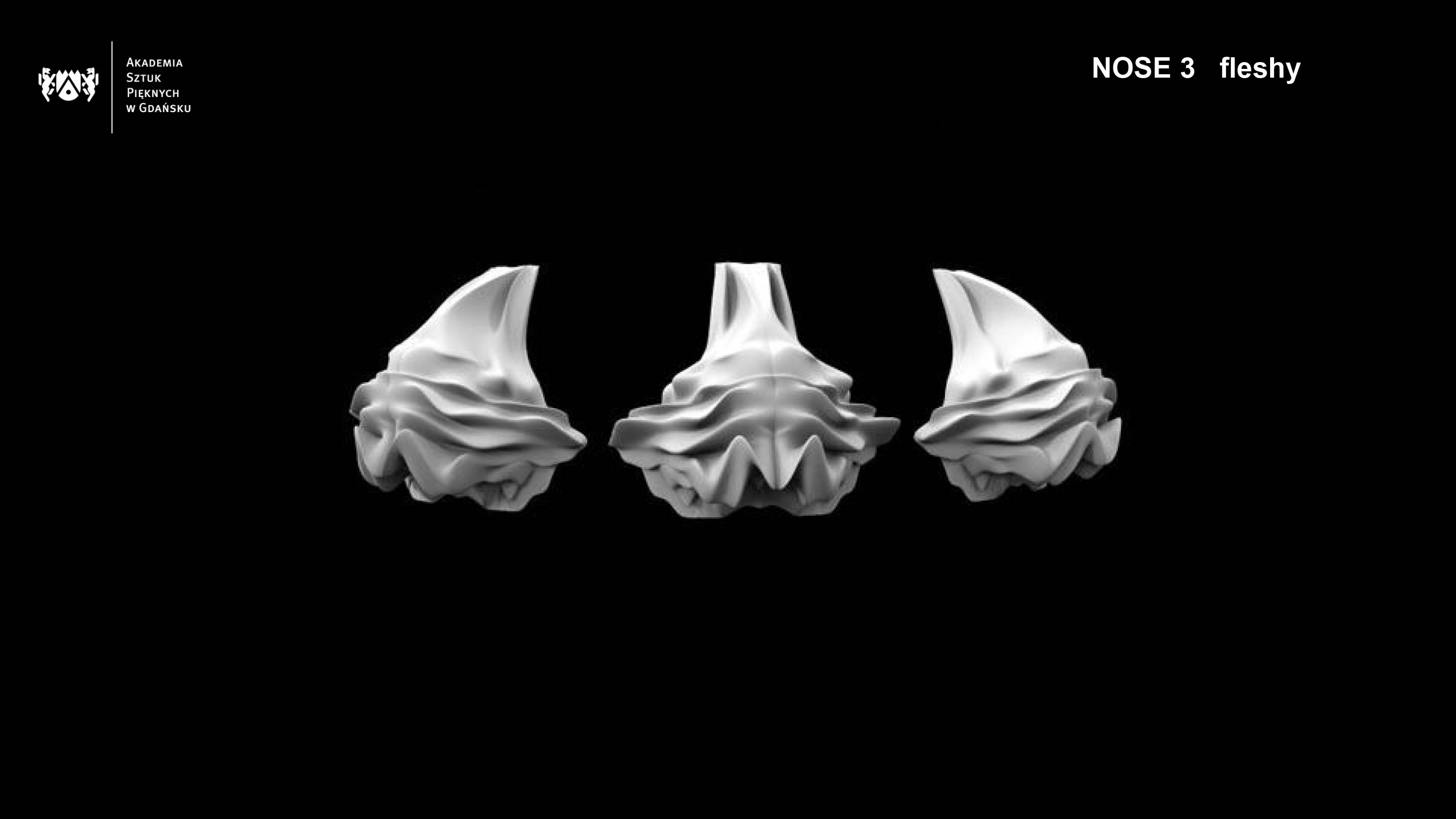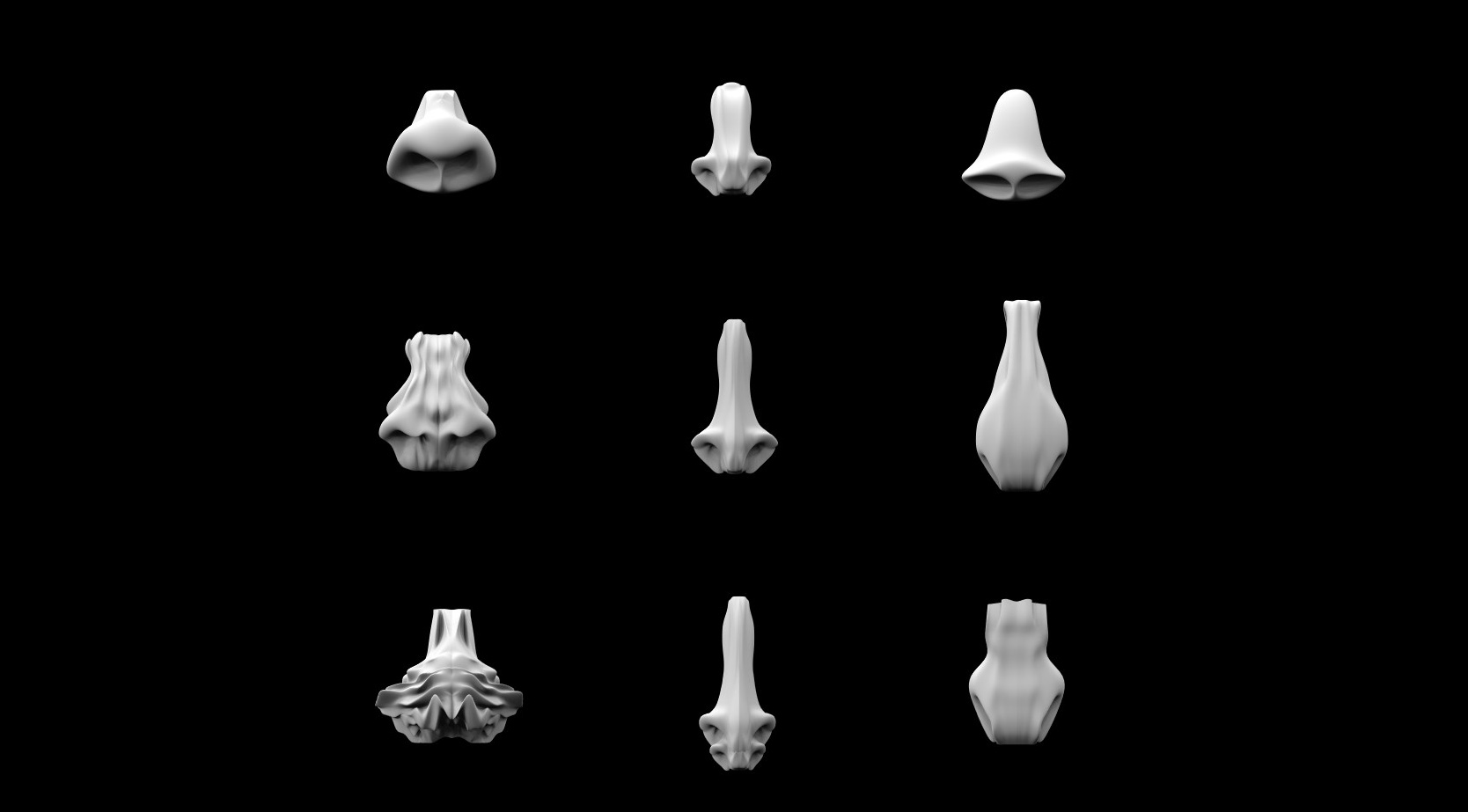Presentation of individual nostril designs
Who nose? A speculative project on the borderline of anthropology, plastic surgery and biomimethics using 3D printing technology and the current state of knowledge in the field of cosmonautics
find more here
Who nose? – Double nostrils
- long narrow noses are genetically associated with Nordic facial features.(Arslan A. Zaidi, Brooke C. Mattern, Peter Claes, Brian McEcoy, Cris Hughes, Mark D.Shriver 2017). This is associated with the fact that with a narrower nose, it is easier to warm up air, as compared to wide nostrils, due to low temperatures, both during travel and after landing.
- On Mars, people will live in habitats. They will wear space suits and helmets while walking on Mars surface and they will be forced to live in air-conditioned spaces. Also the trip itself there will involve staying in air-conditioned rooms.
- Already today, we spend plenty of time in air-conditioned rooms and this has its consequences (allergies, colds, dryness). Analogue astronauts practice such a preparation on Earth.
- we cannot forget about mental factors. Long travel and time spent in closed space may impact anxiety or less severe symptoms such as discomfort. Relaxation techniques inspired by Pranayama breathing exercises show a huge impact of breathing through the nose on staying calm and providing oxygen to the brain. Double nostrils make i possible to strengthen the sense of a deeper breath.
 digital image made by Marta Flisykowska
digital image made by Marta Flisykowska
 3D printed object, polyjet technic photo and design Marta Flisykowska
3D printed object, polyjet technic photo and design Marta Flisykowska
Who nose? – Boxer
- utilising the experience of mountaineers, we know that the nose being an extensive part of the body, is the most prone to frostbite. Additionally, it is also subject to sunburns due to sun rays being reflected from snow. Burns also occur at the bottom of the chin or neck, according to Adam Bielecki, a Polish mountaineer.
Mountaineers use special bands and tapes for covering noses and cheeks that protect against temperature and sun. For this purpose, the model of this nose is made more flat and it sticks out less - the width and size of nostrils in this case is also related to the sense of better ventilation and deeper breath. In the world of animals, such a reference can be observed in the African Buffalo.
- Wide biomimical nostrils and flattened nose may also affect one’s self-confidence. The above-mentioned African Buffalo is one of the most dangerous animals in the World, which is enhanced by the specific nose appearance. An additional stylistic reference regarding a flat nose and wide nostrils is the structure of boxers’ noses, which due to numerous injuries resulting from fights, modify the nose appearance. In the context of new attractiveness, it could create another subject of discussions.
- from the point of view of functionality, such a nose would also be less prone to injuries relating to long use of helmets, that would break the nose in the case of a fall or trip, without securing it.
 digital image made by Marta Flisykowska
digital image made by Marta Flisykowska
 3D printed object, polyjet technic photo and design Marta Flisykowska
3D printed object, polyjet technic photo and design Marta Flisykowska
Who nose? -radiator / resonator
- similarly to the design of radiators, the wavy surface of the nose may impact heat transfer
- the wavy surface reaching deeper may also have a clear impact on one’s voice. The nose is a resonator and has an influence on acoustic effects. Since communication is mainly conducted with the use of microphones, its effect will be the same as in an aircraft cockpit, which means that some frequency will be interrupted by noises, and this will make communication more difficult. In basstraps used in recording studios, you may have noticed wavy structures which contribute to changing the acoustic effect.
- additionally, an example of nose structure of one of the sword nosed bats also shows that the nose is very fleshy. Scientists are of the opinion that this may be associated with echolocation. Due to the disrupted day (Earth) rhythm and the sense of day and night caused by artificial lighting, the trace in research regarding to transfer of waves and vibrations with reference to echolocation, also seems interesting.
 digital image made by Marta Flisykowska
digital image made by Marta Flisykowska

 3D printed object, polyjet technic photo and design Marta Flisykowska
3D printed object, polyjet technic photo and design Marta Flisykowska










